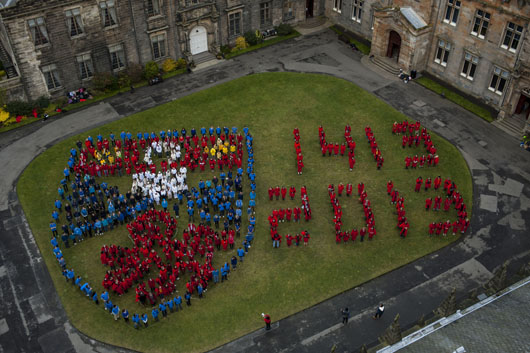Students bring University crest to life

Over 1,000 students at the University of St Andrews gathered in St Salvator’s Quadrangle today (Wednesday 7 November 2012) to bring the University’s coat of arms to life by organising themselves into an extraordinary, mass formation of the iconic crest.
The formation is the largest-scale St Andrews crest ever seen, and has been recorded with an aerial photograph taken from the top of the Chapel Tower. The spectacle was organised as part of the University of St Andrews’ 600th Anniversary celebrations.
The world’s first human St Andrews crest is the brain-child of the Chinese Hongpeo (red gown) Student Society, led by Chang SHI (Wayne), working in collaboration with the student-led Your600th campaign.
Wayne said:
“This project symbolises the shared identity, passion and pride of all individuals in the close-knit university community. The aerial photo taken on top of the tower will leave our mark in history. More than 1,000 people have been involved in this project, which is quite a feat with a university of just over 9,000 students.”
The formation includes the lion rampant, taken from the Royal Arms of Scotland to represent the royal authority of King James I (1406-1437) who was involved in the University’s foundation, which was today formed by students wearing red gowns. The crest also includes an open book representing “learning”, which was shaped by University staff. The rest of the shield was formed by students wearing blue, yellow and white t-shirts.
The University of St Andrews is currently celebrating its 600th Anniversary; spanning three calendar years from 2011 to 2013. It marks the formal charter granted by Bishop Henry Wardlaw in February 1411 and the achievement of full university status conferred by Pope Benedict XIII by Papal Bull in 1413.
The Anniversary has been used to launch a 600th Anniversary Fundraising Campaign which aims to preserve the University’s built and made heritage – including St Salvator’s Quadrangle where the event will be held. The Quadrangle is the oldest remaining part of the University and the heart of many of its traditions. The University hopes to redevelop the site for its seventh century; by landscaping, improving paving, and regenerating garden areas.
Other fundraising projects include scholarships and bursaries, a new centre for Special Collections, improved sports facilities, and the redevelopment of the Students’ Association.
Notes to News Editors
Full details of the formation.
Keep up to date with the Your600th student activities.
Category Student experience